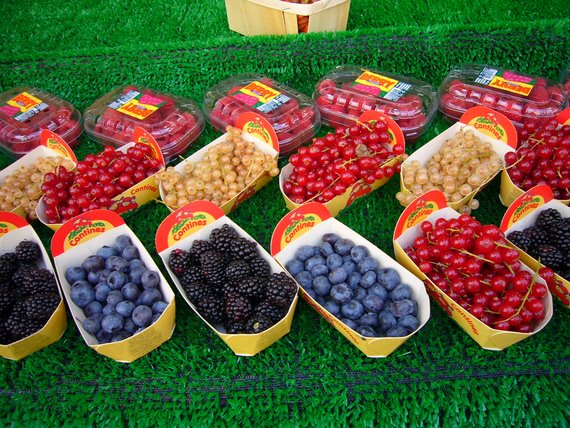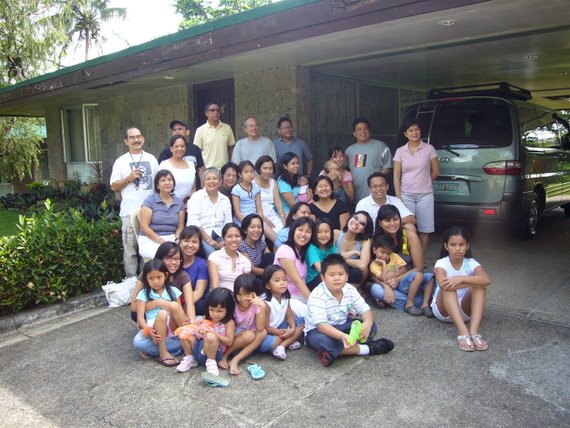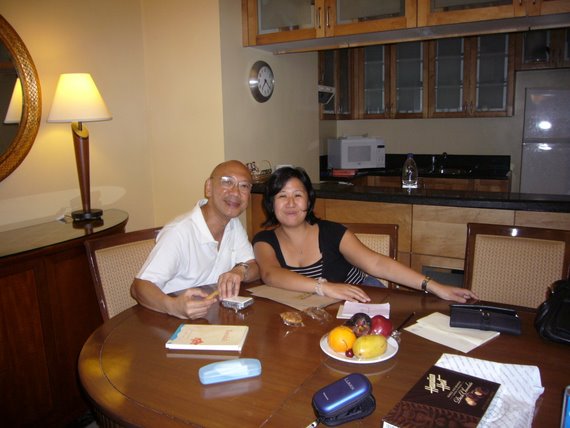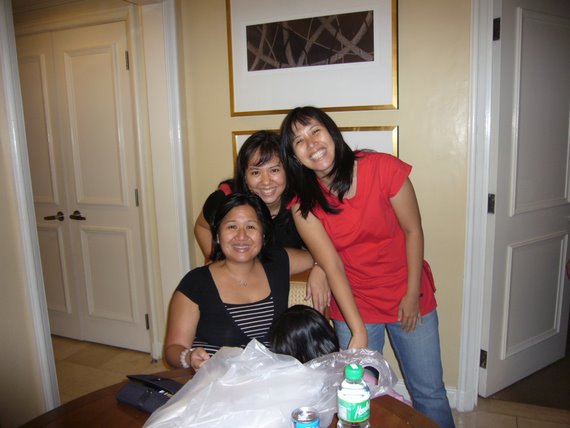
Tuesday, February 20, 2007
If you blur your eyes
...Hanoi is an amalgam of many European cities. Tree lined boulevards and cafes recall Paris. The houses along green canals evoke Amsterdam. And if you look out onto the West Lake, and blur your eyes, it's like your looking at the Arno in Florence. And then parts of the teeming city are a little like old Manila and a little like Bangkok.
Funny
They took it off its frame and rolled it up. They almost forgot about the certificate of authentification. When they brought out the file, there was no signature.
"No problem. We'll take it to his house for his signature...and bring it to your hotel room by nine o'clock tonight," Ms. Lan assured me. Alright, I agreed absently, distracted by the rather novel idea that Dao Hai Phong himself lived in a house in Hanoi, that there he worked, and gallery owners came to take his signature. How strange. Dao Hai Phong himself, working in his studio.
It was mind boggling.
"What if he's not home?" T asked.
"It's the lunar new year. He's probably at home with friends and family. Maybe he's entertaining. Maybe he's working."
But at nine o'clock sharp, the certificate came, signed, sealed and delivered.
"No problem. We'll take it to his house for his signature...and bring it to your hotel room by nine o'clock tonight," Ms. Lan assured me. Alright, I agreed absently, distracted by the rather novel idea that Dao Hai Phong himself lived in a house in Hanoi, that there he worked, and gallery owners came to take his signature. How strange. Dao Hai Phong himself, working in his studio.
It was mind boggling.
"What if he's not home?" T asked.
"It's the lunar new year. He's probably at home with friends and family. Maybe he's entertaining. Maybe he's working."
But at nine o'clock sharp, the certificate came, signed, sealed and delivered.
Philosophising the search of Dao Hai Phong
It was much more difficult than we thought. Due to the limits of wall space as well as the limits of our pocketbook, we had to confine ourselves to certain parameters. But even then, even within those, it was not a cut and dry decision that was easy to make from the very outset.
For one, almost every painting I saw, I felt I would love and be proud to own. Amazingly, each and every one. It was further complicated by Phong's titles - all of which are pleasingly poetic, pleasantly provocative. "Quiet Evening" was a fishing boat, docked into a house on stilts, lit from within. "Twilight Moment" was a small village nestled behind a grove of three trees on a hill, the houses reflected in the still waters of the lake. "Countryside" was a row of houses on red. In his recent work, the artist seemed to be responding to more modern inspirations, the walls of his houses had graffiti - not a bad, there was something there.
"But what do you want most? What do you want to look at every day?" All of them, I thought greedily. I'd like to look at all of them. But T was right, I knew. We are not the kind of people to buy any number of work by one artist. You buy one. The one you like best; the one that likes you. And then you stop.
Being perhaps more existentialist than we needed to be, we asked ourselves, what makes a Dao Hai Phong truly Dao Hai Phong, without which it would not be a Dao Hai Phong? We locked upon his trees like clouds of cotton candy, we liked hills and churches. True, his fishing villages were charming - the house on stilts with the light emanating from it, bouncing of the surface of the water - a rhapsody in deep blue that is at once the sky, at once the sea. Beautiful, without a doubt, but there was just something different about those billowing trees.
"It's not like the fishing scenes are not powerful, they are. But we're not fishing people as much as we are tree people," I said, testing out my theory out loud to see if it held any water. T agreed. Fishing and the sea are great. But we are more about hills and trees and houses.
Finally there was the issue of colour. To make the choice between Phong's blueness or redness or yellowness was tough, as each had its merits. K hazarded her rather mature opinion that red was too hot, and that she preferred the serene of deep blue or the calm of the yellow. But I pointed out to her that because of the way Phong paints, even the red, as bright as it is, is calm and quiet and placid...some kind of magic that he is able to achieve, a gentle message from the eye to the brush, spelt out in the canvas.
In a red one called "New town" there is a cluster of houses on a hill and two trees. There is also the unexpected gift of falling yellow leaves, like the season of autumn.
"New town" had real hope and it grew in all of us. On our final day in Hanoi, we decided to
take it home.
For one, almost every painting I saw, I felt I would love and be proud to own. Amazingly, each and every one. It was further complicated by Phong's titles - all of which are pleasingly poetic, pleasantly provocative. "Quiet Evening" was a fishing boat, docked into a house on stilts, lit from within. "Twilight Moment" was a small village nestled behind a grove of three trees on a hill, the houses reflected in the still waters of the lake. "Countryside" was a row of houses on red. In his recent work, the artist seemed to be responding to more modern inspirations, the walls of his houses had graffiti - not a bad, there was something there.
"But what do you want most? What do you want to look at every day?" All of them, I thought greedily. I'd like to look at all of them. But T was right, I knew. We are not the kind of people to buy any number of work by one artist. You buy one. The one you like best; the one that likes you. And then you stop.
Being perhaps more existentialist than we needed to be, we asked ourselves, what makes a Dao Hai Phong truly Dao Hai Phong, without which it would not be a Dao Hai Phong? We locked upon his trees like clouds of cotton candy, we liked hills and churches. True, his fishing villages were charming - the house on stilts with the light emanating from it, bouncing of the surface of the water - a rhapsody in deep blue that is at once the sky, at once the sea. Beautiful, without a doubt, but there was just something different about those billowing trees.
"It's not like the fishing scenes are not powerful, they are. But we're not fishing people as much as we are tree people," I said, testing out my theory out loud to see if it held any water. T agreed. Fishing and the sea are great. But we are more about hills and trees and houses.
Finally there was the issue of colour. To make the choice between Phong's blueness or redness or yellowness was tough, as each had its merits. K hazarded her rather mature opinion that red was too hot, and that she preferred the serene of deep blue or the calm of the yellow. But I pointed out to her that because of the way Phong paints, even the red, as bright as it is, is calm and quiet and placid...some kind of magic that he is able to achieve, a gentle message from the eye to the brush, spelt out in the canvas.
In a red one called "New town" there is a cluster of houses on a hill and two trees. There is also the unexpected gift of falling yellow leaves, like the season of autumn.
"New town" had real hope and it grew in all of us. On our final day in Hanoi, we decided to
take it home.
Visions of Vietnam
Apparently, the fairly advanced development of the art scene in Vietnam took place largely because of the French occupation and such institutions as Ecole des Beaux Arts d'Indochine, set up by the colonialists in 1925, the harbinger for schools like the Hanoi Institute of Fine Art. Techniques like painting and sculpture were taught intensively, and later, indigenous art forms were added to the curriculum like lacquer painting and silk painting.
As it happens with all colonial histories in which one more powerful country actively takes over one weaker one, there were a few good things that happened amid the bad. And for Vietnam, visual art is one of them. Walking through the galleries in Hanoi alone, one finds many artistic voices worthy of attention - each with a personal vision, a particular discipline, an eye for meaning that is unique, powerful, and beautiful.
Years before we visited the city, I had spent many hours journeying through the websites of various galleries, visiting and revisting my favourites - the pure simplicity of Nguyen Thanh Binh (b. 1954), his serene, creamy spaces, elegantly singular compositions and the colour white which he expertly makes use of as a colour, as opposed to a non-colour. The subtle, single-hued panoramas of Hong Viet Dung (b. 1962)and the joyful street scenes of Le Than Son (b. 1962)
And then there are the poignant, surreal storybook visions of Dao Hai Phong (b. 1965) that never fail to elicit my wordless satisfaction. Most of his paintings enchant, because they deftly achieve the rare but keen pleasure located in the intersection where brightness and quietness meet and sometimes fall in love.
See http://www.thavibu.com/vietnam/dao_hai_phong
So when at last we paid the city of Hanoi a visit, it was my heartfelt wish, my intent to find a Dao Hai Phong that called my name. I wanted to find one and take it home that I might escape into it everyday, if I so chose. Not merely to look at it and admire it as a possession. But to actually engage in it, enter it, be one with it.
In the end, this, is what art is ultimately about.
As it happens with all colonial histories in which one more powerful country actively takes over one weaker one, there were a few good things that happened amid the bad. And for Vietnam, visual art is one of them. Walking through the galleries in Hanoi alone, one finds many artistic voices worthy of attention - each with a personal vision, a particular discipline, an eye for meaning that is unique, powerful, and beautiful.
Years before we visited the city, I had spent many hours journeying through the websites of various galleries, visiting and revisting my favourites - the pure simplicity of Nguyen Thanh Binh (b. 1954), his serene, creamy spaces, elegantly singular compositions and the colour white which he expertly makes use of as a colour, as opposed to a non-colour. The subtle, single-hued panoramas of Hong Viet Dung (b. 1962)and the joyful street scenes of Le Than Son (b. 1962)
And then there are the poignant, surreal storybook visions of Dao Hai Phong (b. 1965) that never fail to elicit my wordless satisfaction. Most of his paintings enchant, because they deftly achieve the rare but keen pleasure located in the intersection where brightness and quietness meet and sometimes fall in love.
See http://www.thavibu.com/vietnam/dao_hai_phong
So when at last we paid the city of Hanoi a visit, it was my heartfelt wish, my intent to find a Dao Hai Phong that called my name. I wanted to find one and take it home that I might escape into it everyday, if I so chose. Not merely to look at it and admire it as a possession. But to actually engage in it, enter it, be one with it.
In the end, this, is what art is ultimately about.
Subscribe to:
Comments (Atom)
Kids on break

So what are you going to do about it?
Reminder: Buy fruit

Likewise, Quintosians rule

on with family business
FLASHBACK MANILA

Isang Sandali
Sisterhood rules

Here's to being the best we can be!
Apparently, this is me. Now which card are you?

You are The Wheel of Fortune
Good fortune and happiness but sometimes a species of intoxication with success
The Wheel of Fortune is all about big things, luck, change, fortune. Almost always good fortune. You are lucky in all things that you do and happy with the things that come to you. Be careful that success does not go to your head however. Sometimes luck can change.
What Tarot Card are You?
Take the Test to Find Out.

